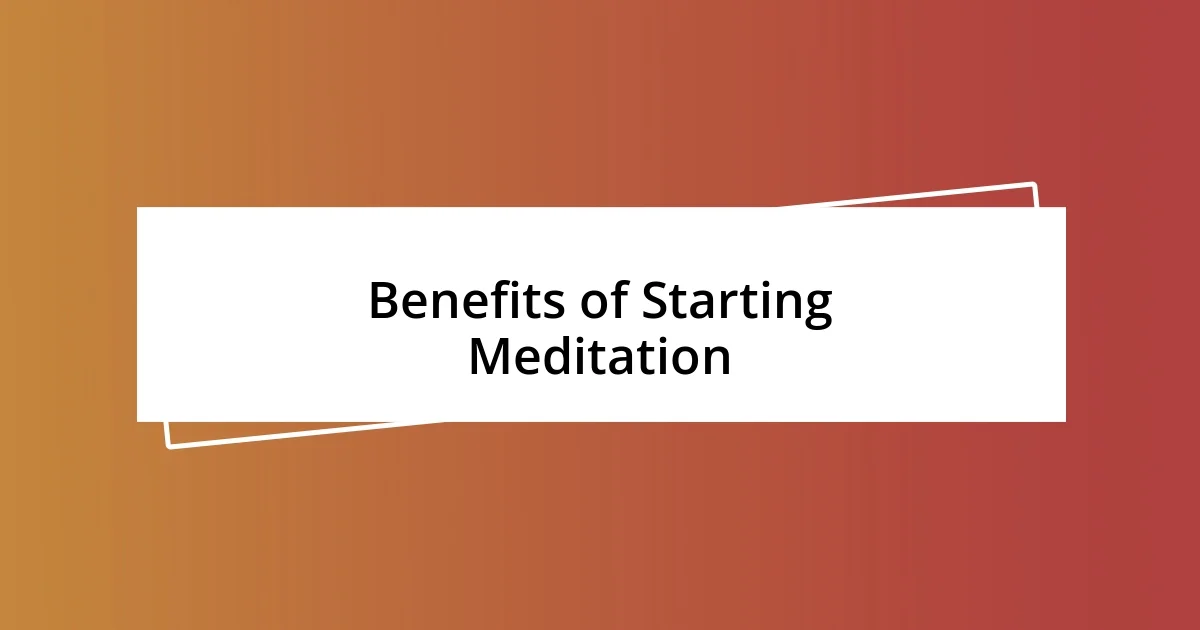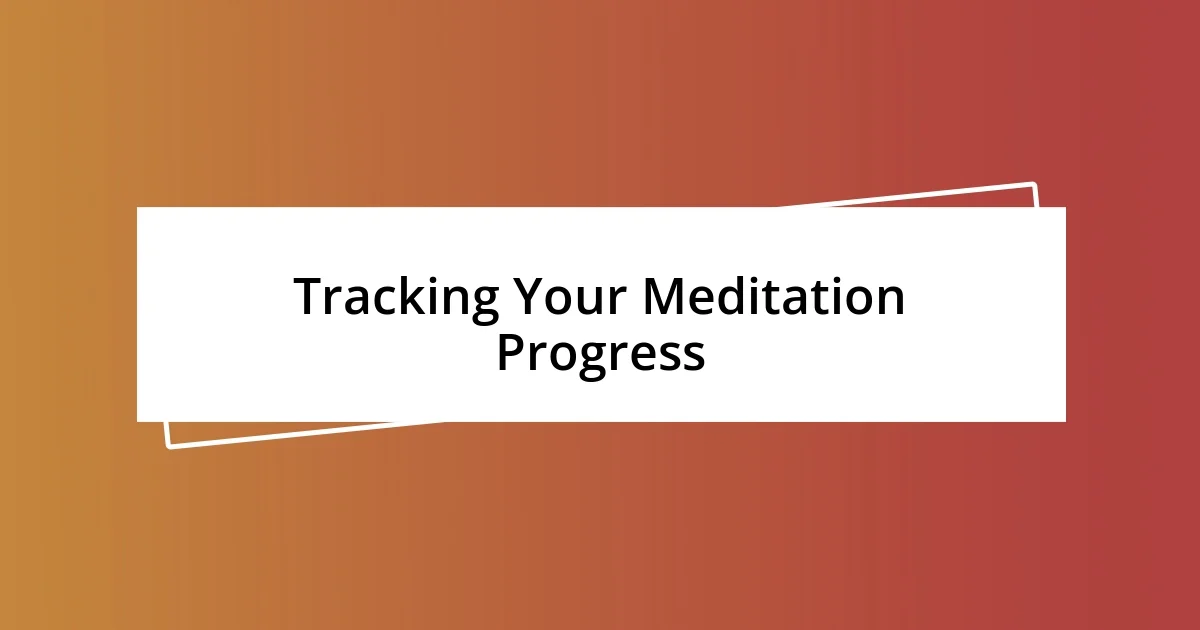Key takeaways:
- Meditation is about observing thoughts without judgment and gently guiding focus back, rather than forcing silence.
- Creating a dedicated and inviting meditation space enhances the practice by minimizing distractions and promoting a calm atmosphere.
- Tracking progress and reflecting on sessions deepens self-awareness and motivation, fostering personal growth in meditation practice.

Understanding Meditation Basics
Meditation is essentially about finding a moment of calm amidst the chaos of daily life. I remember my first attempt at meditation; I was both excited and anxious. I sat down, closed my eyes, and immediately felt overwhelmed by racing thoughts—did I really think I could quiet my mind that easily?
As a beginner, it’s important to understand that meditation is not about forcing your mind to be silent. Instead, it’s about observing those thoughts without judgment and learning to gently bring your focus back—something that took me a while to grasp. Each time I noticed my mind wandering, I learned to appreciate those moments as part of the process rather than failures.
Another essential aspect is the various forms of meditation, from mindfulness to guided visualization. For instance, when I discovered guided meditations that included soothing music or calming voices, it transformed my experience. Have you ever felt how a simple sound can create a safe space for your thoughts? That’s the beauty of meditation—it’s highly personal, and what works for one may not work for another, which is perfectly okay.

Benefits of Starting Meditation
Starting meditation can open up a treasure trove of benefits that I never anticipated. One of the most profound changes I experienced was a greater sense of awareness. Initially, I thought meditation was just about relaxation, but it truly cultivates mindfulness in everyday moments. When I started to practice regularly, I felt more present during conversations, savoring each word instead of letting my mind wander elsewhere.
Here are some key benefits that stood out to me:
- Reduced Stress: I noticed that just a few minutes of meditation helped alleviate my daily anxieties.
- Improved Focus: My ability to concentrate significantly improved, allowing me to work more efficiently.
- Emotional Balance: I became more equipped to handle life’s ups and downs with a calm perspective.
- Better Sleep: In those nights when my mind wouldn’t slow down, meditation became my soothing bedtime ritual.
- Increased Creativity: I found that quieting my mind sparked ideas and solutions to problems I couldn’t see before.
Embracing meditation has been like unearthing a hidden garden—each benefit blooming and enriching my life in unexpected ways.

Preparing Your Meditation Space
Preparing your meditation space can be a transformative experience in itself. When I first began, I had the idea that I could meditate anywhere. However, I soon realized that having a dedicated spot made a huge difference. I set up a small corner in my home, adorned with soft cushions, candles, and even a few plants. The simple act of arranging my space helped signal to my mind that it was time to unwind and focus.
Creating an inviting atmosphere is essential. I learned this through trial and error. On days when I rushed into meditation without setting the mood, I felt restless and unable to settle. But on days when my space was calm and inviting, it felt like everything clicked into place—my thoughts quieted, and I eased into the process more effortlessly. Lighting a candle or using an essential oil diffuser became my little rituals that signaled the start of my meditation time. Have you ever noticed how scent can evoke feelings of peace?
Think about decluttering your meditation area as well. I found that removing distractions from my sight allowed my mind to let go of external chaos. Now, I keep my space free of anything that might pull my attention away. It’s amazing how a simple, uncluttered environment can enhance the meditation experience.
| Considerations | Examples |
|---|---|
| Comfort | Use cushions, blankets, or a meditation bench to find a comfortable seating position. |
| Atmosphere | Incorporate calming elements like candles, plants, or soft lighting to create a serene ambiance. |
| Scent | Use essential oils, incense, or scented candles to enhance relaxation and focus. |
| Organizing | Keep your space uncluttered and free of distractions to promote a clear mind. |

Choosing the Right Meditation Technique
Choosing the right meditation technique can feel overwhelming at first, but it doesn’t have to be. I remember my initial confusion when faced with options like mindfulness, loving-kindness, and body scan meditations. Each method serves a unique purpose, so I found it helpful to explore a few techniques before landing on the one that resonated most. Have you ever tried an unfamiliar style only to realize it aligns perfectly with your needs? This exploration phase can be eye-opening.
I often recommend starting with guided meditations, especially for beginners. Listening to someone lead you through a session can ease anxiety and help focus your thoughts. In the beginning, I would use apps that offered a range of practices. One particular session on breath awareness transformed my understanding of the technique; it taught me to notice each inhale and exhale, creating a foundation I still rely on today.
Finally, don’t underestimate the importance of personal preference. I knew I preferred shorter sessions, allowing me to gradually build my practice. The first time I found a technique that clicked—a five-minute morning meditation—I felt a rush of relief. It was like discovering a gentle tap on my shoulder, guiding me into a new routine. What about you? Have you found a technique that feels just right? I encourage you to listen to your intuition as you experiment; it often knows best.

Structuring Your Meditation Routine
Structuring your meditation routine is like building a personal roadmap to peace. I started with a fixed time each day, which transformed my practice into a sanctuary I always looked forward to. Consistency helps, doesn’t it? With a specific time, I began associating meditation with the calm that would wash over me, a sort of mental handshake that marked the beginning of my mindful journey.
Next, I discovered the beauty of setting a timer. Initially, I felt unsure about how long I should meditate, so I started with just five minutes. Honestly, I was shocked at how quickly that time flew by! Gradually, I increased my sessions to ten and then fifteen minutes. This simple act gave me the freedom to truly delve into each moment without the distraction of wondering when it would end. Every beep of the timer became a gentle nudge, reminding me to embrace the experience fully.
Lastly, I think it’s crucial to reflect on your meditation after each session. I began keeping a journal to jot down my thoughts or any insights that emerged. It was fascinating to look back and see my evolution over time. What did I learn from today’s session? Was there a moment of clarity or an emotion that bubbled up? These reflections deepened my understanding and kept me engaged. Isn’t it amazing how a few minutes of quiet can unravel the threads of our thoughts?

Overcoming Common Challenges
One of the biggest hurdles I faced was my racing mind. At first, sitting still felt impossible as thoughts charged through my head like a wild stampede. I learned to embrace that chaos instead of fighting it. By acknowledging my thoughts—simply observing them without judgment—I slowly found peace in the midst of that mental disorder. Have you experienced this too? It’s all part of the process.
Another challenge was dealing with expectations. Initially, I thought I needed to feel completely zen after each session, but that led to disappointment. I remember a day when I finished meditating and felt more restless than before. It took me a while to realize that meditation isn’t about achieving a perfect state of calm; it’s about being present with everything, even discomfort. When was the last time you allowed yourself to simply be, without the need for a specific outcome?
Finding a distraction-free space was also essential. I discovered that creating my own little meditation corner made a world of difference. At first, I’d try to meditate in noisy areas, but that only made things harder. It became clear to me that a cozy nook—complete with cushions and soft lighting—was crucial for my practice. Where do you feel most relaxed? Sometimes, a change in environment is all you need to help clear the mental clutter.

Tracking Your Meditation Progress
Tracking your meditation progress has opened up a whole new dimension for me. I started by checking in with myself after each session, asking questions like, “How did I feel today?” or “Was I fully present?” This reflection became a practice in self-awareness. I found it fascinating to notice patterns over time—some days my mind was clearer, while others were more chaotic. Isn’t it intriguing how our state of mind can fluctuate so dramatically?
As I continued, I began using an app to log my sessions. This brought a sense of accountability and made tracking my consistency feel like a small achievement. Every time I hit a milestone, like meditating for a week straight, it boosted my motivation. Plus, the visual of my progress chart truly inspired me. Have you tried using technology to assist your meditation journey? It’s remarkable how something so simple can create a rewarding sense of accomplishment.
Now, I also take note of the insights that arise during my practice. I jot down any significant thoughts or experiences—sometimes even phrases that resonated with me deeply. One evening, I stumbled upon the idea that “just being is enough,” which lingered with me throughout the week. This habit of tracking insights has helped me cultivate a richer understanding of my practice. What breakthroughs have you found in your moments of stillness? Tracking these revelations not only allows for growth but makes each meditation unforgettable.












